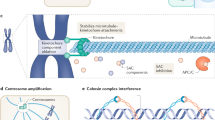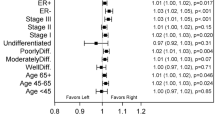Abstract
Cellular DNA content of primary tumours from 280 patients with operable breast cancer was determined by flow cytometry using nuclei from paraffin sections stained with DAPI, and 199 of these patients were followed for 8-13 years after surgery. Tumours from 67 patients have also been analyzed for their DNA content using single cell suspensions from fresh tumour tissue stained with mithramycin and ethidium bromide, and the results compared with those obtained from paraffin blocks of the same tumours. Overall 60% of the tumours contained cells with abnormal DNA content (DNA-aneuploid populations). Survival and disease free interval were not significantly different in patients with DNA-diploid and DNA-aneuploid tumours when analysed by Mantel's life table method. There was however, an early advantage for patients with DNA-diploid tumours: during the first 30 months after surgery DNA-aneuploidy was associated with higher rate of recurrence and shorter survival. DNA-aneuploidy was strongly related to histological grade. Thus 11/49 (22%) grade I, 60/102 (59%) grade II, and 96/129 (74%) grade III tumours were DNA-aneuploid. Although there was no significant difference in survival of patients with DNA-diploid and DNA-aneuploid tumours overall, there appears to be an unexpected association between DNA-aneuploidy and better survival in grade II patients (P less than 0.01); a similar trend was observed for grade I patients. Although the proportion of DNA-aneuploid tumours was similar in oestrogen receptor positive and negative tumours, DNA-aneuploidy was associated with lower levels of oestrogen receptors in comparison to DNA-diploid tumours. Comparison between the modal DNA values of fresh and paraffin embedded samples showed high rate of comparability (64/67, P less than 0.0001).
This is a preview of subscription content, access via your institution
Access options
Subscribe to this journal
Receive 24 print issues and online access
$259.00 per year
only $10.79 per issue
Buy this article
- Purchase on Springer Link
- Instant access to full article PDF
Prices may be subject to local taxes which are calculated during checkout
Similar content being viewed by others
Rights and permissions
About this article
Cite this article
Owainati, A., Robins, R., Hinton, C. et al. Tumour aneuploidy, prognostic parameters and survival in primary breast cancer. Br J Cancer 55, 449–454 (1987). https://doi.org/10.1038/bjc.1987.88
Issue Date:
DOI: https://doi.org/10.1038/bjc.1987.88
This article is cited by
-
The evolving paradigm of cell-nonautonomous UPR-based regulation of immunity by cancer cells
Oncogene (2016)
-
Taxane benefit in breast cancer—a role for grade and chromosomal stability
Nature Reviews Clinical Oncology (2013)
-
DNA ploidy and S-phase fraction in medullary carcinoma of the breast -a flow cytometric analysis using archival material
Breast Cancer Research and Treatment (1994)
-
Markers of prognosis in breast cancer - the relationship between binding of the lectin HPA and histological grade, SPF, and ploidy
Breast Cancer Research and Treatment (1993)
-
Nuclear and flow cytometric characteristics associated with overexpression of the c-erbB-2 oncoprotein in breast carcinoma
Breast Cancer Research and Treatment (1991)



